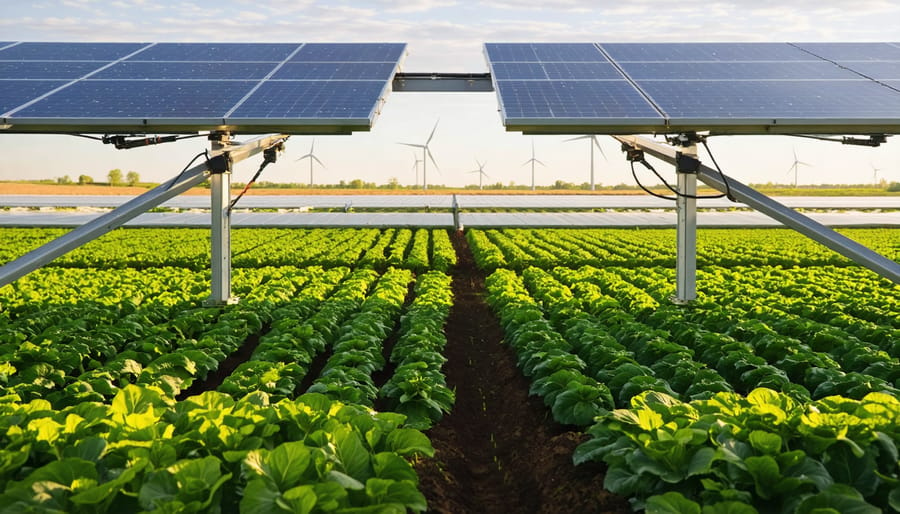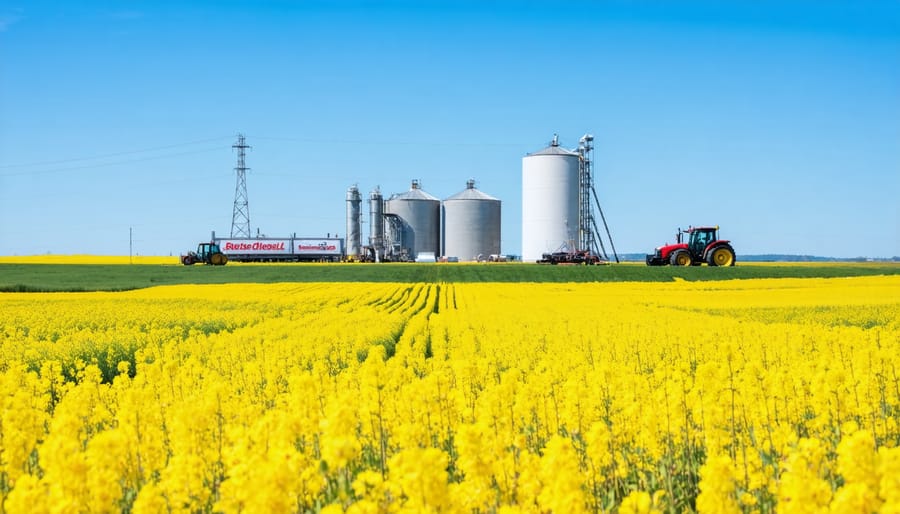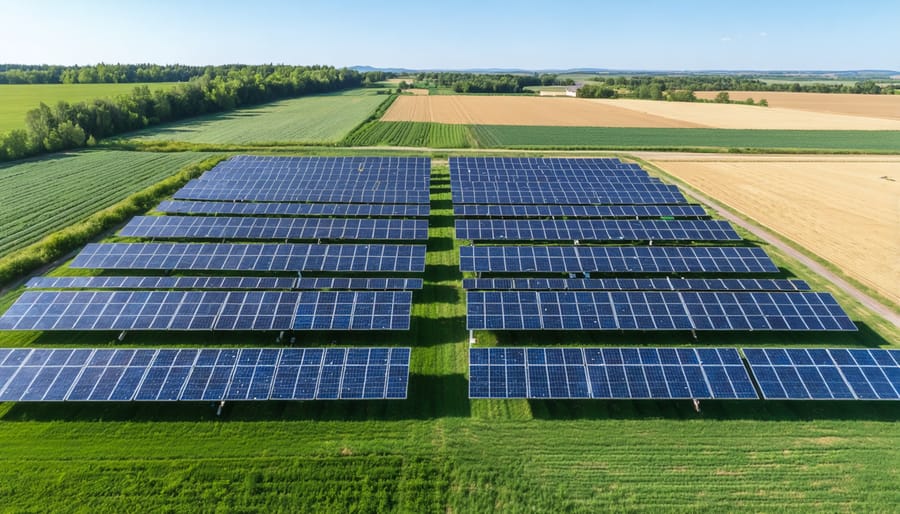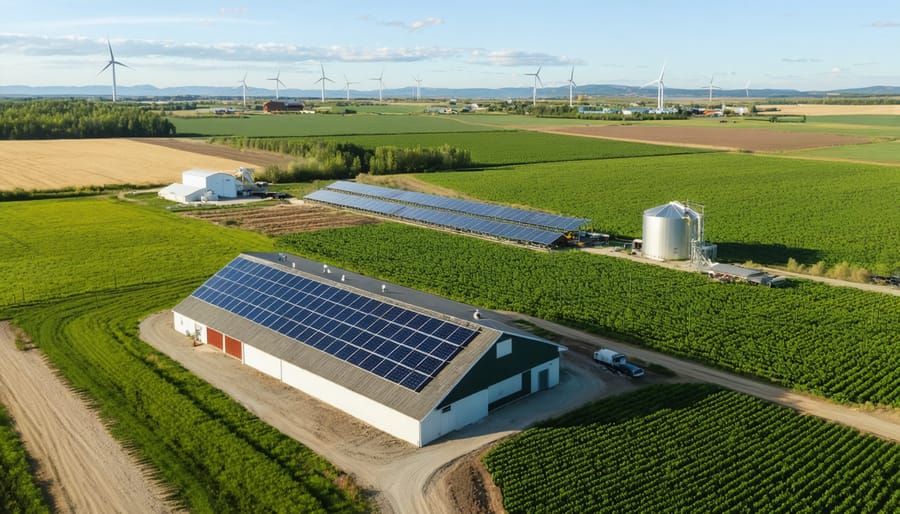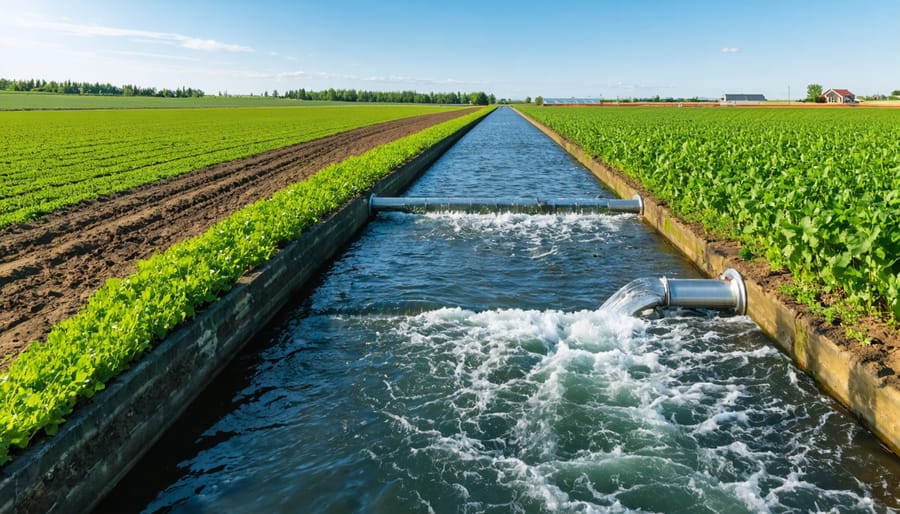Transform your flowing creek into reliable farm power with small-scale hydro power systems that generate 5-15 kW daily—enough to power essential farm operations year-round. Canadian farmers already harness creek power to slash electricity costs by 40-60% while maintaining steady output during winter months when solar panels struggle. Modern micro-hydro turbines, specifically designed for agricultural properties with elevation drops of just 2-3 metres, now deliver consistent power generation with minimal environmental impact. Install these systems alongside existing irrigation infrastructure to maximize efficiency and reduce implementation costs, creating a sustainable power source that pays for itself within 5-7 years under current Alberta agricultural incentive programs.
Creek Power Basics: Your Farm’s Hidden Energy Source
Understanding Flow and Head: Is Your Creek Suitable?
Before installing a creek hydro system, you’ll need to assess two critical factors: flow rate and head (the vertical drop of water). In Alberta’s varied landscape, even modest creeks can pack surprising potential if these measurements are favorable.
To measure flow, start by timing how long it takes a floating object to travel a set distance in your creek. Multiply the average surface speed by 0.8 to account for friction, then multiply by the creek’s cross-sectional area. For reliable power generation, you’ll want a minimum flow of 20 litres per second during the driest months.
Head is equally important – the higher the vertical drop, the more power you can generate. Measure head using a water level, GPS device, or professional survey. Most successful farm installations need at least 2 metres of head, though systems can work with less if flow is substantial.
For a quick estimate of your creek’s potential, multiply the flow (in litres per second) by the head (in metres), then divide by 10. This gives you a rough power output in watts. Remember that seasonal variations will affect your system’s performance, so measure during different times of the year.
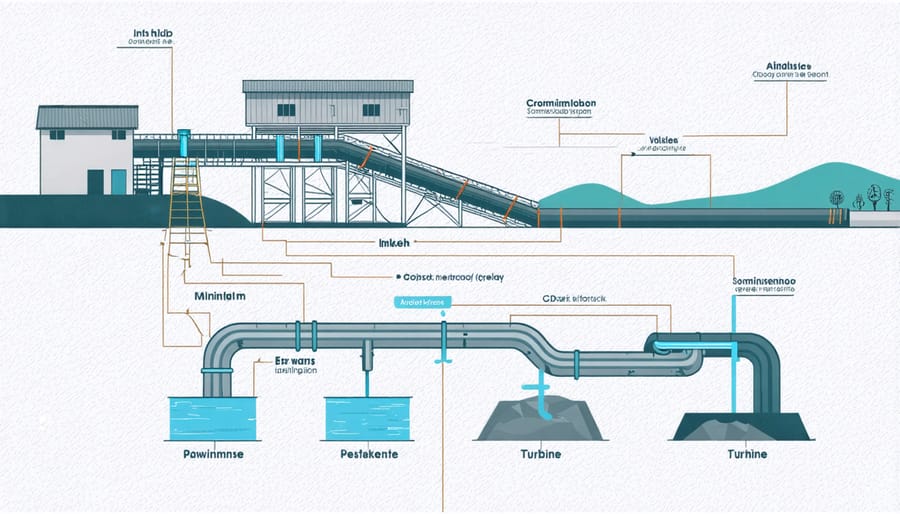
Essential Components of a Farm Creek Power System
A successful creek hydro power system relies on several key components working together seamlessly. The intake structure, typically positioned upstream, captures water while filtering out debris through a protective screen. This connects to the penstock, a pressurized pipe that channels water downhill, usually constructed from durable PVC or metal materials suitable for Canadian weather conditions.
The powerhouse, which can be as simple as a weatherproof shed, houses the turbine and generator assembly. For most Alberta farm applications, a Pelton or cross-flow turbine proves most effective, especially with our varying seasonal water flows. The generator converts mechanical energy into electricity, typically producing between 2-10 kW for a small farm setup.
Essential control equipment includes a charge controller, inverter, and battery bank for consistent power supply. Most systems also require a tailrace channel to safely return water to the creek. Safety features like emergency shutoffs and overflow systems are crucial, particularly during spring runoff.
For monitoring and maintenance, basic tools include flow meters, pressure gauges, and electrical monitoring equipment. Many Alberta farmers find that adding a simple debris deflector upstream helps reduce maintenance needs during autumn leaf fall.
Real Results: Alberta Success Stories
The Thompson Family’s Year-Round Power Solution
Located just outside of Red Deer, Alberta, the Thompson family’s 240-hectare mixed farming operation has become a model for sustainable farm solutions in the region. In 2019, they installed a micro-hydro system on Pine Creek, which runs through their property, transforming their energy independence year-round.
“We used to worry about power outages during critical operations like grain drying and winter livestock care,” explains Sarah Thompson. “Now, our 5-kilowatt system provides consistent power regardless of the season.”
The Thompsons’ system utilizes a small dam with a 3-metre head height, channeling water through a 20-centimetre intake pipe to a turbine housed in a weatherproof shed. During spring runoff, the system generates surplus power, while maintaining steady output even in winter thanks to the creek’s continuous flow.
The installation cost $45,000, with 30% covered by Alberta’s Farm Energy Program. The family reports annual energy savings of $4,800, putting them on track for full cost recovery within seven years. More importantly, the system powers their entire barn complex, greenhouse operations, and main workshop.
“What surprised us most was the minimal maintenance,” notes John Thompson. “Besides quarterly intake cleaning and annual bearing checks, the system practically runs itself. It’s become as reliable as the creek itself.”

Mountain View County’s Community Creek Project
Mountain View County’s innovative creek hydro project stands as a shining example of what rural communities can achieve through collaboration. Launched in 2019, this initiative brings together 12 local farming families along Pine Creek to harness sustainable power while maintaining ecological balance.
The project utilizes a series of small-scale turbines strategically placed along a 15-kilometre stretch of the creek. Each installation generates between 5 and 10 kilowatts of power, enough to offset roughly 60% of a typical farm’s electrical needs during peak flow seasons.
What makes this initiative particularly noteworthy is its cooperative management structure. Participating farmers formed the Pine Creek Energy Cooperative, sharing both costs and benefits. The initial investment of $425,000 was partially funded through provincial green energy grants, with members contributing the remainder.
Local farmer Sarah Thompson, who helped spearhead the project, notes: “We’ve created something that benefits everyone. The power generation helps our bottom line, but we’re also preserving the creek’s health through careful water management and monitoring.”
The project includes fish-friendly turbine designs and maintains minimum flow requirements to protect aquatic ecosystems. Regular water quality testing and habitat assessments ensure environmental sustainability. The success of this initiative has inspired similar projects in neighbouring counties, demonstrating how creek hydro power can support both agricultural operations and environmental stewardship.
Starting Your Creek Power Journey
Environmental Permits and Water Rights
Before installing a creek hydro system in Alberta, you’ll need to secure several key permits and water rights. Start by contacting Alberta Environment and Protected Areas to apply for a Water Act licence, which grants you the right to divert and use water from the creek. This process typically takes 3-6 months and requires detailed documentation of your proposed water usage and system design.
You’ll also need to obtain a development permit from your local county or municipal district. Many jurisdictions now have specific provisions for small-scale hydropower projects, making the process more straightforward for farmers.
Environmental assessments are usually required, particularly if your creek supports fish populations. Working with a qualified environmental consultant can help ensure your project meets all regulatory requirements while protecting local ecosystems.
Don’t forget to register with the Alberta Utilities Commission if you’re planning to connect to the grid. For systems under 150 kilowatts, there’s a simplified micro-generation application process that most farm-scale projects can use.
Local watershed management groups can be valuable resources during the permitting process, often providing guidance based on similar projects in your area.
Installation and Maintenance Timeline
The journey to implementing creek hydro power typically spans 6-12 months from initial assessment to full operation. Begin with a spring site evaluation when water flow is highest, followed by summer flow measurements to establish minimum capacity. Early fall is ideal for permit applications and system design, allowing for installation before winter sets in.
Installation starts with constructing the intake system, which usually takes 1-2 weeks depending on terrain. Many Alberta farmers find success with basic settling tanks and leaf guards, which help prevent debris accumulation. The penstock installation follows, requiring careful trenching and stabilization – typically a 3-4 day process for most small-scale systems.
Powerhouse construction and turbine installation generally takes 2-3 weeks. Local contractors familiar with farm construction can handle most of the work, though specialized technicians should oversee final turbine placement and electrical connections.
Regular maintenance follows a seasonal schedule:
– Spring (March-April): Clear winter debris, check intake screens
– Summer (June-July): Monitor water levels, clean filters
– Fall (September): Prepare system for winter, clear leaves
– Winter (Monthly): Ice management, ensure continuous flow
Annual professional inspections are recommended, typically costing $500-800. Most Alberta farmers report spending 2-3 hours monthly on basic maintenance tasks. With proper care, these systems commonly operate effectively for 20-25 years, making them a long-term investment in farm sustainability.
Cost Analysis and Available Grants
Initial costs for creek hydro power systems typically range from $20,000 to $100,000, depending on system size and site conditions. However, Alberta farmers can access several funding opportunities to offset these expenses. The Canadian Agricultural Partnership (CAP) offers grants covering up to 30% of project costs for on-farm renewable energy initiatives, including micro-hydro installations.
The Alberta Municipal Climate Change Action Centre (MCCAC) provides additional funding through their Clean Energy Improvement Program, which can cover up to 40% of eligible costs. Local farmers have reported system payback periods of 5-8 years when combining grants with energy cost savings.
Operating costs remain relatively low, averaging $500-$1,000 annually for maintenance and periodic equipment checks. Many Alberta farmers find that creek hydro systems deliver consistent returns through reduced electricity bills and potential revenue from excess power generation through Alberta’s micro-generation regulation.
For detailed cost planning, the Alberta Agriculture and Forestry department offers free consultations with renewable energy specialists who can help assess site potential and develop financial projections specific to your farm operation.
Integration with Farm Operations
Irrigation Systems and Water Management
Creek hydro power systems can significantly enhance irrigation and water management on Canadian farms, offering a sustainable approach to water distribution. By integrating these systems with existing water infrastructure, farmers can create pressurized irrigation networks without relying on grid power or diesel pumps.
In the foothills of Alberta, several farms have successfully implemented creek-powered irrigation systems that maintain consistent water pressure across their fields. These setups typically include a small intake reservoir that doubles as a settling pond, helping to remove sediment before water enters the irrigation lines. The hydro system’s steady power output ensures reliable pressure for pivot irrigation systems and drip lines, even during peak growing seasons.
For example, the Morrison family farm near Red Deer uses their creek hydro setup to power a sophisticated irrigation network covering 80 hectares of cropland. Their system includes pressure-regulated zones that automatically adjust water distribution based on soil moisture sensors, maximizing efficiency while minimizing water waste.
Water management becomes more precise with these systems, as the constant power supply allows for automated controls and scheduling. Many farmers have reported water savings of 20-30% compared to traditional irrigation methods, while also noting improved crop uniformity. During non-irrigation seasons, the same hydro system can be redirected to power other farm operations, making it a versatile investment for year-round sustainability.

Storage Solutions and Grid Integration
Managing power supply and demand is crucial for creek hydro systems on Canadian farms. Integrating hydroelectric microgrids with modern energy storage solutions helps maintain consistent power delivery throughout seasonal flow variations.
Battery banks are the most common storage method, allowing farmers to store excess power generated during peak flow periods for use during lower flow seasons. Many Alberta farmers are finding success with lithium-ion batteries, which offer excellent performance in our climate and require minimal maintenance.
Pump storage systems are another practical option, where excess power is used to pump water to elevated storage tanks. This stored water can later generate electricity when needed, creating a reliable backup system during dry spells or maintenance periods.
Grid-tie systems enable farms to feed excess power back into the local utility grid, providing additional income through net metering programs. This approach is particularly valuable for operations with variable power needs throughout the year.
For optimal performance, consider incorporating smart controllers that automatically manage power distribution based on your farm’s usage patterns. These systems can prioritize critical operations during peak demand and redirect excess power to storage or secondary uses, ensuring nothing goes to waste.
Creek hydro power represents a sustainable and practical solution for Canadian farmers looking to reduce their energy costs while contributing to environmental stewardship. Throughout Alberta and beyond, successful installations have demonstrated that small-scale hydroelectric systems can provide reliable power for agricultural operations while preserving natural water resources.
The benefits of creek hydro power extend far beyond cost savings. These systems offer year-round power generation, require minimal maintenance once properly installed, and can last for decades with proper care. For farms with suitable water resources, micro-hydro installations can provide energy independence while maintaining normal creek flow and protecting aquatic ecosystems.
As our agricultural sector continues to evolve, implementing renewable energy solutions like creek hydro power positions farmers at the forefront of sustainable farming practices. The initial investment, while significant, is offset by long-term energy savings and potential government incentives for clean energy adoption.
We encourage you to take the next step in exploring creek hydro power for your farm. Start by conducting a preliminary assessment of your water resources and connecting with local agricultural extension services or renewable energy consultants. Many farmers across Alberta have already embraced this technology, creating a supportive community willing to share their experiences and insights.
Remember, every sustainable choice we make today helps ensure the vitality of Canadian agriculture for future generations. Your creek could be more than just a water source – it could be the key to your farm’s energy independence.



